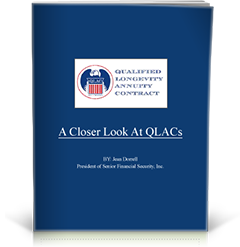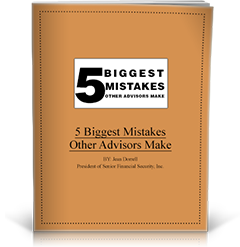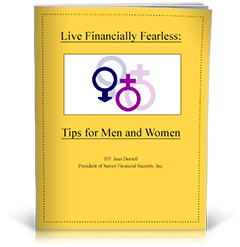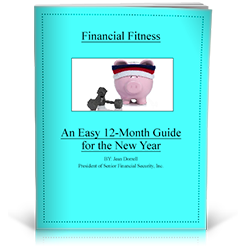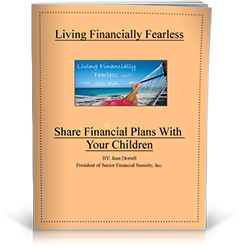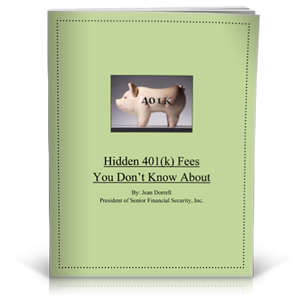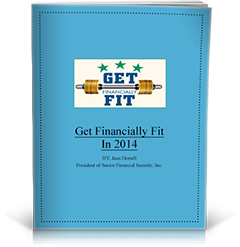Is Just “Riding Out” The Market and Holding On Damaging Your Retirement Portfolio?
A Closer Look At QLACs
On July 1, 2014, the Department of Treasury and the IRS approved the use of a longevity annuity with qualified accounts, called a Qualified Longevity Annuity Contract (QLAC). It is important to note that the QLAC (pronounced cue-lack) is not a new product. The idea was actually introduced in 2004. Although, a QLAC is the result of a new IRS ruling of an existing product structure, the Longevity Annuity.
5 Biggest Mistakes Other Advisors Make
In my 25 years in the insurance and annuity industry, I have seen all sorts of financial mistakes, a lot of which have been made by other advisors and attorneys of my clients prior to them arriving at Senior Financial Security, Inc. These are some of the biggest, and most common, mistakes I have seen to date.
Live Financially Fearless: Tips for Men and Women
Over the past two decades, researchers have confirmed what comedians have known forever: Men don’t like to ask for directions, and women like to have confirmation and do things in the company of others. Men are from Mars and women are from Venus. These fundamental stereotypes especially show up in the different ways these two groups approach finances. One thing I have learned in my 25 years in the financial industry is the way men and women manage, view and process information they receive about money, seems to be in two different universes.
Financial Fitness: An Easy 12-Month Guide for the New Year
It’s a brand new year! One resolution we should all make (and KEEP) this year is to get our finances into shape. Let me help you with this free month-to-month guide that’s easy to follow and will help you achieve financial fitness.
Living Financially Fearless: Share Financial Plans With Your Children
The older we get, the more serious we get about making financial plans for the future – investments, wills, trusts, retirement, death etc. We hear experts say, “Make sure you have a plan!” We all know it’s smart to have a plan for every potential scenario. One thing we often forget or put off is to make sure we share these plans with our children.
Living Financially Fearless is a series of e-books written by Jean Ann Dorrell. Each edition consists of important facts and tips that should help reduce financial stress. Each e-book provides useful tools that will bring you closer to living financially fearless!
Hidden Investment Fees You Don’t Know About
In today’s world, we know that with most services comes that dreaded word: FEES (especially in the financial world!). Now, fees are not always a bad thing. They are an important part of good business. However, there are a few investment options that charge very high fees, and might not be worth the potential benefits you will receive by selecting them as part of your financial portfolio. As a CEP, founder of Senior Financial Security, Inc., and being in this business for over 20 years, it is my job to educate you on all types of investments: good and bad. I want you to be aware and informed on some specific fees that might be incurred: what they are and how they affect your portfolio.
Hidden 401(k) Fees You Don’t Know About
The good news is that if you have a 401(k) plan, you are on the right path to a successful retirement. In 2011, an AARP study showed that most people have a 401(k) and are knowledgeable in the amount they would like to have saved up by the time they retire. The bad news is that a lot of Americans do not realize they could be losing thousands of dollars a year due to fees associated with their 401(k)’s. The same study found seven out of ten people were not aware they pay fees to their 401(k) plan provider to maintain their account. When told of these fees, three in five were not aware, or did not feel knowledgeable, of the amount they pay in fees.
The Gray Divorce
Twenty years ago, divorce rates were said to be as high as 50% in the US. While that number has been steadily dropping, divorce rates for people 50 and over has doubled in that time. In 1990, just 1 in 10 marriages were ending in divorce for people over 50; today it is 1 in 4. A study performed by sociologists at Bowling Green State University predicted the number of post 50 divorces could easily surpass 800,000 per year by 2030. Experts refer to this growing trend as The Gray Divorce. Why is this happening? How does this differ from younger couples experiencing divorce? What can people experiencing The Gray Divorce do to navigate through this difficult time in their lives?
Senior Traps to Avoid: How to Protect Yourself from Common Scams
According to the National Council on Aging (NCOA), financial scams targeting seniors have become so prevalent they are now considered “the crime of the 21st century.”
Seniors are a big target for common money scams and identity theft for several reasons. First, seniors typically, or are thought to, have large amounts of money in their various accounts, own their own home, and/or have good credit. In addition, financial scams often go unreported, so they are considered a “low-risk” crime. This is especially true with seniors because 1) they might not know who to report to, 2) are too ashamed they have been scammed, or 3) are completely unaware they have been scammed. However, when financial scams are reported, seniors tend to make poor witnesses. With the effects of age on memory, con artists are counting on seniors not being able to name key details or descriptions. Finally, fraudsters believe they can fluster seniors in several scenarios, so they believe there is a better chance seniors will act on their emotions and do something sudden. This “must act now” attitude has gotten many seniors in trouble.
Get Financially Fit in 2014
It’s a brand new year! This is a time we all start talking about our goals for the year ahead. We want to lose weight, get organized, quit smoking and the list goes on. Each year, more than 40% of Americans will make at least one New Year’s resolution, but only 8% of us will keep it. One resolution we should all make and keep this year is to get financially fit.
There are many things we would like to do to get our financials in shape, so this goal may seem a bit daunting at first. With a long “to-do” list, vague resolutions and good intentions won’t do it. We have to have a plan. That is why I have divided up this long “to-do” list and created a 12-month guideline that is easy, manageable and achievable. It isn’t hard to get overwhelmed by all there is to do, but by taking each financial target one month at a time, you are well on your way to becoming financially fit.

